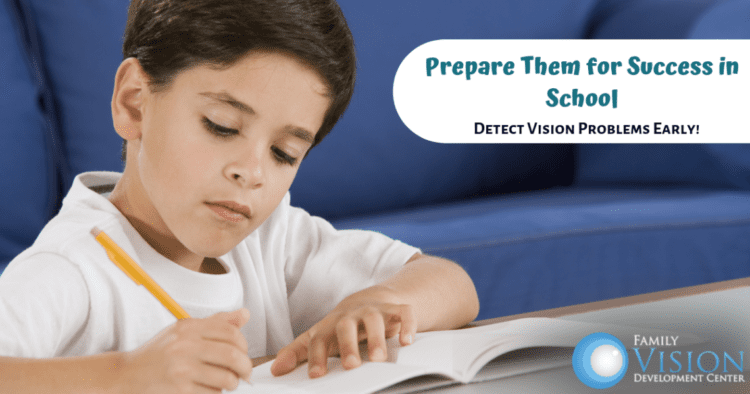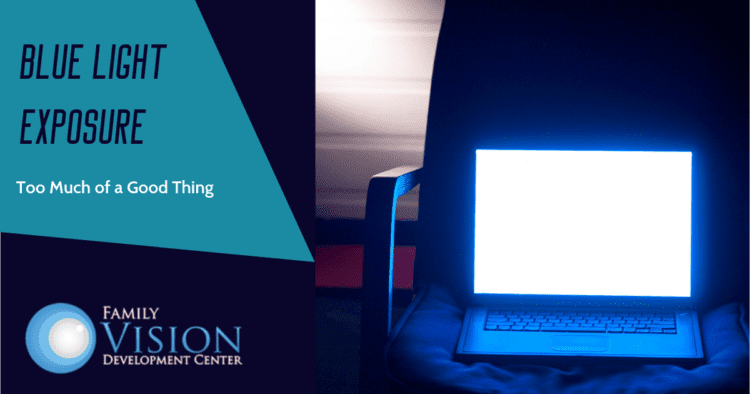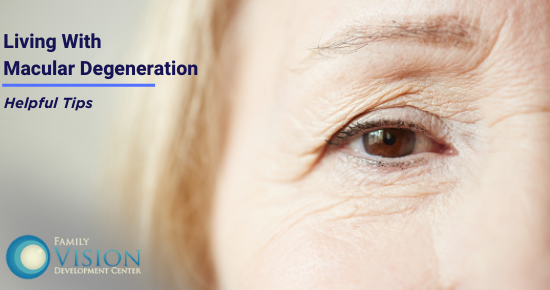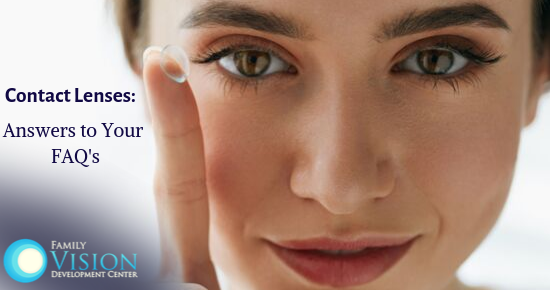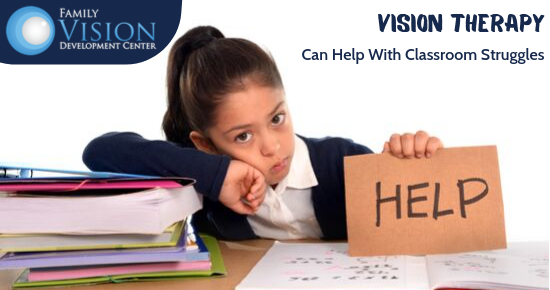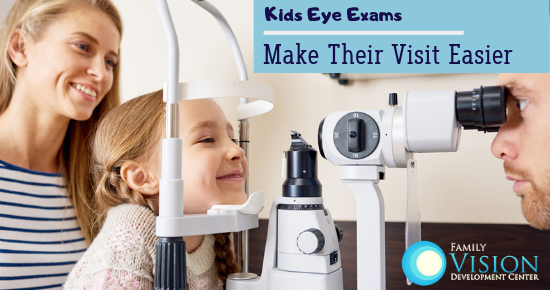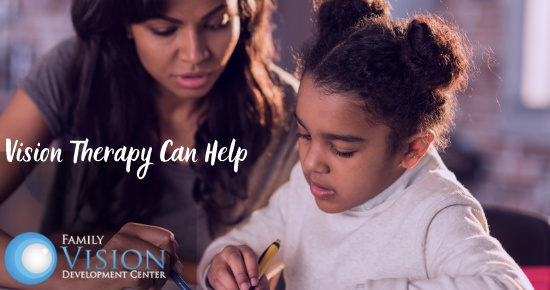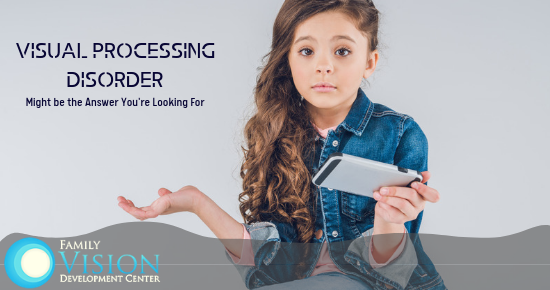When a child has vision problems, it can affect many areas of their daily life, including their learning ability. And it may not be as evident as blurred vision – a child could have perfectly clear eyesight, but still have vision issues that can prevent them from achieving success in school.
Types of Vision Problems
There are several types of vision problems, all of which can affect your child’s ability to read, write and succeed in the classroom in different ways. The following are some common vision problems in children that may interfere with learning ability.
Children with a refractive error have an irregularly shaped cornea that does not bend light properly. This can cause blurred vision, difficulty reading things up close or a crossing of the eyes. If your child holds a book very close to their eyes or squints when trying to read or see the front of the classroom, they may be suffering from a refractive vision problem.
- Functional Vision Problems
These refer to problems affecting the way that the eyes and brain work together. This can lead to problems in eye teaming (binocularity), accommodation (i.e., the ability of the eye to focus on an object at different distances), hand-eye coordination, peripheral vision or fine eye movements. A child with a functional vision problem may experience double vision, transposing letters, confusing similar words, difficulty with reading, spelling and math, and poor performance in sports.
- Perceptual Vision Problems
Perceptual vision problems are characterized by difficulty understanding and identifying what one sees. A child with poor visual perception may have 20/20 vision, but might have trouble distinguishing between two similar letters (such as u and n), putting a puzzle together or finding a pair of matching socks in a drawer. Other signs of a visual perception disorder could include skipping words or lines when reading, memorization trouble, or understanding a map.
While parents may be quick to assume that their child’s learning ability is determined by their study habits, or even genetics, they may not even think to look at their vision. A comprehensive eye exam at Family Vision Development Center can uncover any vision conditions or disorders that can lead to poor performance in school. Vision therapy programs are a very effective way to treat these types of vision conditions, and early detection often provides more opportunity for treatment options. Contact us today at 630-862-2020 or visit us online to schedule an appointment.
Blue light is produced naturally by the sun and is also generated by computer monitors, smartphone screens and other digital devices. Although the light has some beneficial effects, exposure can increase your eyestrain risk and even affect your central vision.
What Is Blue Light?
The rays of the sun may appear to be colorless, but they’re actually made up of red, blue, orange, yellow, green and violet hues. Blue rays emit higher amounts of energy, and therefore they’re more likely to affect your eyes.
Much of your exposure to blue light comes from the sun, but you can’t avoid exposure simply by staying indoors. In addition to computer monitors and smartphones, it is produced by tablets, LED and fluorescent lights, LED light from TVs and compact fluorescent light bulbs. Blue light plays an important role in maintaining the sleep/wake cycle, regulating your mood and keeping your memory sharp – but too much of it can keep you awake at night and can be harmful to your eyes.
Too Much Exposure Can Cause Eyestrain
If you have ever experienced blurred vision, headaches or burning, itching eyes after spending hours in front of a digital screen, it could be the result of prolonged exposure to blue light. Staring at electronic devices for extended periods of time can result in digital eye strain. This occurs when your eyes continually try to focus on a screen, which pulls at the eye muscles until they become fatigued.
Central Vision May Be Affected by Blue Light
Blue light penetrates all the way to the retina (the inner lining of the back of the eye) and can cause damage to the light-sensitive cells in the retina. Long-term exposure may increase your risk of developing age-related macular degeneration (AMD), which occurs when the retina deteriorates and results in vision loss in the center field of vision.
Blue light exposure can also pose a higher risk to those who have recently had cataract surgery. A cataract serves as a natural protective lens for the eye, so when the cataract is removed, your exposure increases and precautions should be taken to filter out blue light when possible.
Protecting Your Eyes From Blue Light
Some blue light is good, and necessary, as it can boost alertness, help with memory and cognitive function and elevate mood. However, too much is not good and the following precautions can help protect your eyes from excessive harmful blue light exposure.
- Buy a Filter – Adding a blue light filter to your screens can improve contrast and lower the amount of blue light that your eyes absorb.
- Take Breaks – Taking frequent breaks from your computer, tablet or phone helps lower your exposure and also gives your eyes a chance to rest. Breaks don’t have to be long. If your day is hectic, simply looking away from your computer for a minute or two every 20 minutes can be helpful.
- Try New Glasses – If you spend much of your day working on a computer, you may want to consider buying a pair of prescription computer glasses. The glasses block blue light, improve contrast and help reduce eyestrain.
- Consider Blue Light-Blocking Lenses After Cataract Surgery – Special lenses that reduce blue light transmission can be used in place of clear lenses after your cataract surgery.
Family Vision Development Center in Aurora assists in providing important information regarding the safety of your eyes, as well as providing crucial services such as comprehensive eye exams that indicate vision conditions like AMD, vision therapy services to treat certain disorders and a wide selection of prescription glasses to effectively correct your vision. Contact us at 630-862-2020 to schedule your appointment or learn more about our practice here: https://www.fvdcpc.com/about/
Macular degeneration is not a diagnosis you want to receive. Unfortunately, as many as 11 million people in the U.S. are living with some form of the disease. While there is no current cure for macular degeneration, there are some things you can do to make daily living a little easier.
What is Macular Degeneration
Macular degeneration is a condition that affects the central part of the retina (the macula) which causes blurred or loss of vision in the central field of vision. It may happen very slowly at first but become more severe as it progresses, and it may occur in one or both eyes. And while it may not cause complete blindness, losing your central vision can make activities like driving, cooking or reading much more difficult.
How to Change Your Lifestyle After a Macular Degeneration Diagnosis
There is no quick fix for macular degeneration, but a change of lifestyle can definitely help to improve symptoms or prevent it from getting worse.
- Quit smoking – studies have shown a strong link between smoking and developing macular degeneration, so the best thing to do for the health of your eyes is to quit immediately.
- Eat a variety of nutritious foods – the antioxidants in fruits and vegetables are good for retinal health and can help stop progression of the disease. And fish contains omega-3 fatty acids which are thought to improve eye health.
- See your doctors regularly – visit your primary care doctor to keep an eye on your blood pressure and cholesterol, and see your eye doctor for regular eye exams to monitor the disease and discuss alternative treatment options if necessary, as well as adjust your eyeglass prescription when appropriate.
- Improve lighting in the house – using brighter lamps that cover the whole room, desk lamps for targeted light or under-cabinet lighting in the kitchen can all aid in vision around the house.
- Take advantage of low vision electronic aids – there are a multitude of low vision products out there that can help when your eyesight is not as good as it used to be. Try handheld or desktop magnifiers, large-button phones, clocks with large numbers, or try audio books if reading becomes difficult.
It is important to remember – the only way to diagnose macular degeneration is through a comprehensive eye exam, which is why it is so important to visit us on a regular basis. Early detection can allow for more treatment options, and early treatment can help stop the disease from progressing. Don’t put off your eye exam – contact Family Vision Development Center at 630-862-2020 or visit us online to learn more.
Additional information can be referenced here.
There are different options for vision correction, and what you choose depends on a number of different factors. Family Vision Development Center offers a wide range of options for both eyeglasses and contact lenses. We will thoroughly explain the benefits of each during your comprehensive vision exam, but here are some basic facts about contacts to get you started:
Can I Wear Contact Lenses?
Most people are able to wear contact lenses safely and comfortably. There are contact lenses that correct for nearsightedness, farsightedness, astigmatism, and other vision problems. A comprehensive eye exam can determine what lenses are appropriate for you.
Are Contact Lenses Safe For My Eyes?
Millions of people wear contact lenses without any difficulties. Following recommendations for inserting, removing, cleaning, storing, and replacing contacts typically keeps your eyes safe and healthy. However, if you have specific concerns about contact lens safety, we are here to make sure your questions get answered.
What Is The Difference Between Hard And Soft Lenses?
Soft contact lenses are made of plastic combined with water. Soft lenses allow oxygen to pass through the material to your cornea, nourishing and soothing the surface of your eye. Rigid gas permeable contact lenses, sometimes called “hard lenses” are made from a stiffer, oxygen-permeable material. They are often used by individuals with astigmatism or higher-order aberrations.
How Often Should I Change My Contact Lenses?
The frequency with which you should dispose of lenses depends on the contact lens type. Some lenses are made to be disposed of each night, while others may last several weeks. Talk to us during your appointment and read the instructions on your contact lens package to determine the replacement schedule for your lenses.
Is It Possible To Lose A Contact Behind My Eye?
No. If you rub your eyes or swim underwater with contacts, it is possible to dislodge your contacts. Usually, they can be found under your upper eyelid and removed without difficulty.
How Long Does It Take To Adjust To Wearing Contacts?
If you’re not used to wearing contacts, you may notice them or feel slight discomfort for a day or two. As you become accustomed to the lenses, you will no longer even notice that they’re there.
There are a lot of variables to consider when choosing contact lenses. Think about your typical routine and talk to us during your eye exam to find the perfect selection for your lifestyle. Visit Family Vision Development Center in Aurora or contact us at 630-862-2020 to schedule your appointment.
Vision therapy, also referred to as vision training, neuro-vision therapy, or vision rehabilitation, is an optometry subspecialty. Vision therapy is a type of physical therapy for the eyes and brain, and is used to develop, improve and/or enhance visual function. Vision therapy can be beneficial for individuals of all ages. The goal of treatment is to work toward eliminating vision problems and improving a patient’s quality of life by maximizing vision performance and comfort.
How Vision Therapy Works
A vision therapy program involves a series of eye “exercises” and procedures, performed in the office by our highly-trained visual therapists, and specifically tailored to each individual patient. The in-office programs may involve the use of specialized equipment such as corrective or therapeutic lenses, prism lenses, balance boards or visual-motor-sensory integration training devices. Patients may also be given at-home exercises on a weekly basis in order to reinforce the progress made in the office.
A successful program can help a patient develop their visual skills and abilities, improve the efficiency of their vision, or change how they process or interpret visual information.
Who Benefits From Vision Therapy?
Vision therapy is especially beneficial for individuals with ocular motor dysfunctions, binocular dysfunctions, accommodative dysfunctions, visual motor and visual perception disorders, learning-related vision problems, traumatic brain injuries, myopia control, amblyopia, and strabismus. Vision therapy may also be prescribed for patients seeking sports vision enhancement.
An effective therapy program is customized to meet the needs of an individual. For example, if you are seeking sports performance enhancement, you will receive therapy designed to improve visual processing speeds, reaction times, visual endurance, accuracy, and eye teaming. Individuals with vision-related learning difficulties will receive therapy that focuses specifically on improving the visual input skills and visual processing skills required for efficient reading, writing, spelling and mathematics.
Family Vision Development Center Offers Expert Vision Therapy Programs
At Family Vision, our specialty is neuro-optometric rehabilitation and vision therapy. Dr. Martin is specially trained to treat a variety of vision related conditions using the most advanced and up-to-date vision therapy techniques, and Dr. Santoyo-Johnson is a board-certified Fellow in Light Therapy by the College of Syntonic Optometry. Our experience and dedication to the field allows our patients to feel confident that they are receiving the best care possible. Contact us at 630-862-2020 for more information or request an appointment online.
Additional information can be referenced here.
A visit to the eye doctor can be a little overwhelming for young patients, especially if it’s the first visit. Even with a friendly, welcoming the staff, small children may feel shy or find vision testing machines and gadgets a little intimidating. Luckily, parents can make an optometrist visit much less daunting by following a few of these suggestions.
Don’t Keep Your Child in Suspense
Whether you’re 3 or 33, new situations are a lot less scary if you know what to expect. Before your child’s optometrist visit, explain the purpose of the visit. (You want to make sure he or she can see well.) Use age-appropriate language to explain the various steps in the eye examination process, which usually include a review of your child’s medical and vision history, a physical examination of the eyes and eyelids, and a visual assessment to determine if your child can see clearly.
During the assessment, your son or daughter will be asked to look at images or letters. Preschoolers may view several large capital Es that face in different directions. They’ll use their hands to indicate which direction the arms of the Es point. If your child knows the letters of the alphabet, he or she will read the traditional Snellen eye chart.
Eye drops may be used to dilate your child’s pupils. Dilation helps the optometrist view the retina, a light-sensing layer of cells that line the back of the eye. Although the drops aren’t painful, they will make your son or daughter’s vision a little blurry. Be sure to mention that the eye doctor will also look in your child’s eyes with a small light during the examination.
Choose the Best Appointment Time
Kids, like all of us, tend to feel a little more energetic at certain times of the day. If you want to make the optometrist visit as pleasant as possible, choose a time when your son or daughter is usually happy and well-rested. Scheduling visits during your child’s usual meal or nap time, immediately after a nap, or at the end of a long day can result in a cranky child who is reluctant to participate in the vision assessment.
Appointments usually last an hour or less, but may take longer if your child’s eyes are dilated or if you want to select eyeglass frames at the end of the visit.
Distract and Engage
The eye doctor will make every effort to see your child at the appointed time, but that doesn’t mean you won’t spend a little time in the waiting room completing paperwork. Prepare for any possible waiting time by bringing a few toys or books from home to keep your little ones occupied.
Offer a Little Reassurance
Some kids hop on the exam chair without prompting, while others aren’t quite as brave. If your young child is nervous or anxious, feel free to hold him or her in your lap during the assessment and examination. Older children may feel more confident if you stay by their sides or sit in a nearby chair during the visit with the optometrist.
When Should You Take a Child to Their First Optometrist Visit?
The American Optometric Association recommends that children visit the optometrist for the first time at 6 – 12 months old, followed by another visit between 3 and 5 years of age, then yearly visits from ages 6 to 18. However – it is important to remember that these are just guidelines. If you notice any issues with your child’s vision, always bring them in. Early detection of vision disorders can make a difference in the effectiveness of treatment, so it is better to be safe. Consult this Parent’s Checklist to look for early signs of vision impairment.
Contact Family Vision Development Center at 630-862-2020 or request an appointment online HERE
Discovering that your child has a vision disorder can be frustrating and overwhelming. You may see them struggling with everyday activities and want to do everything you can to help get the problem corrected. Vision Therapy is a type of visual training (like physical therapy for the eyes and brain) that uses a series of eye exercises to recover normal visual skills. It is very successful for treating many types of vision disorders including amplyopia (lazy eye), crossing eyes, visual tracking issues, focusing or convergence issues, or visual impairment due to a concussion or traumatic injury.
If you are considering Vision Therapy as an option, but are not sure if it is right for your child, read about these parents’ experiences after bringing their kids to Dr. Martin at the Family Vision Development Center in Aurora.
Vision Therapy Can Help With School Struggles
Prior to vision therapy, our son struggled in school. He avoided reading and anything that had to do with writing. Homework was a nightmare and very stressful on the household.
Since he has completed the vision therapy program, school has become easier & he no longer needs reading programs. If it wasn’t for Dr. Martin & his team, I believe things would have progressively got worse.
–Parent of C.C.
Before we started Vision Therapy, getting our daughter to do homework was a nightmare! No first grader should have to sit at the table for nearly an hour writing ten words. She was diagnosed with ADHD because of this lack of focus.
I learned about Vision Therapy and decided to go forward with it. The last few weeks really opened the door for her – she’s reading chapter books! She is blazing thru her math problems & she’s gotten more coordinated physically.
I am SO GLAD we found Dr. Martin while she’s this young – the future is now firmly in her own hands.
–Parent of A.H.
Thanks for all of your work with our son! He’s reading at grade level now and he gets more work done at school so he’s bringing home less homework!
–Parent of R.J.M.
Vision Therapy Can Bring the Joy Back to Reading
Thanks to the whole Family Vision team! My daughter is now an avid reader who is happy to pick up a book! What a change 6 months can make.
–Parent of M.H.
Thank you Family Vision for helping my son. He has been improving on his grades in school because he can now focus better. I think his concentration and being able to retain information has improved as well.
I was most excited when I saw him actually reading a book for fun! That never happened before!
–Parent of B.M.
Vision Therapy Can Improve Quality of Life
What an amazing life changing journey this has been for not only our son, but for us as well!
Before Vision Therapy, he struggled for years in school. Every evening there was homework for hours. His self-confidence was very low.
From the beginning, Dr. Martin & staff had a goal for him that no one else thought he was capable of. We cannot thank you enough for opening so many doors that were shut before.
Love you guys!
–Parent of H.S.
The Family Vision Team Really Cares
We’re very happy for our son’s therapy results! Dr. Martin put together a fantastic team to make it happen & make it a pleasant experience each week.
The environment is very positive – we really appreciate the knowledge, patience, & professionalism that Dr. Martin, Kim, & Nancy have demonstrated. We would recommend the team to anyone who needs a good, efficient, & cost-effective eye therapy.
–Parent of C.Y.
Vision Therapy may not be the right choice for every child, but Dr. Martin will do a comprehensive eye health and vision evaluation before starting any treatments in order to develop the most effective treatment plan for your child. Contact us at 630-862-2020 or request an appointment online to speak with our team and learn more about our advanced Vision Therapy services.
Family Vision Development Center carries an extensive line of designer glasses in order to offer our clients the very best selection, no matter your face shape, preferences or lifestyle. And we are proud to carry two top-quality brands that you won’t find at many other offices in the area.
Maui Jim
When it comes to quality eyewear, it doesn’t get much better than Maui Jim. You might know them best for their sleek sunglasses, but that’s not all they do. Their MauiPassport prescription lenses offer edge-to-edge clarity you won’t find in other brands. Their state of the art technology and lens design delivers the widest possible field of view, while eliminating 99.9% of glare, enhancing color and contrast and promoting eye health.
Maui Jim eyeglasses are available in stylish designs with exclusive lens technology that truly enhances your daily vision. Each pair comes with features like scratch-resistant, anti-reflective and advanced hydrophobic coatings, as well as 100% UV protection. Other features are also available to suit your specific needs, and your vision experts at Family Vision Development Center will help you select the perfect pair.
Nike Vision
You may not immediately associate the Nike brand with designer glasses, but who is better to develop quality eyewear for active people than a leader in the sports industry? Nike understands quality and durability and it shows in their extensive line of eyeglasses and sunglasses perfect for the elite athlete.
Nike prescription glasses and sunglasses come in a wide variety of shapes, colors and materials to suit any lifestyle while staying on trend for both men and women. And keeping athletes in mind, their cutting-edge technology allows for maximum performance in your sport of choice with virtually distortion-free optics. Frames are available with features like integrated spring hinges, rubberized nose pads, adjustable frame features and materials like titanium, lightweight plastic and Flexon memory metal.
Visit Family Vision Development Center in Aurora to see our full line of designer glasses and sunglasses, including Maui Jim and Nike. It is important to consider materials, designs and coatings before making your final selection, and we are here to help you make the best choice. Contact us at 630-862-2020 or request an appointment online.
Unlike problems that involve actual eyesight or sharpness of vision, visual processing disorders affect how visual information is processed by the brain. A child may have 20/20 vision, but still struggle with processing things like symbols, pictures or distances. Visual processing disorders can hinder a child’s ability to learn properly in the classroom and can also present challenges while playing sports or socializing with peers, all of which can have a negative effect on their self-esteem.
Signs of Visual Processing Disorder
There are certain signs or symptoms to watch for that would indicate that a child may have trouble with visual processing. These could include:
- Difficulty distinguishing between similar letters, shapes or objects.
- Difficulty distinguishing a figure from its background
- Tendency to skip lines when reading, or read the same line over and over
- Trouble writing within the lines, copying from a book or bumping into things when walking
- Trouble remembering what they’ve seen or read
- Difficulty determining how close objects are to each other
- Difficulty identifying an object when only parts of the object are showing
- Frequent reversal of numbers, letters or words
- Organization problems
- Untidy handwriting
- Poor retention of visual classroom material
Vision Therapy is One Treatment Option
Vision therapy is a kind of physical therapy for the visual system which includes the eyes and brain, and can produce successful results for correcting visual processing disorders. In-office, one-on-one vision therapy treatments can improve visual processing speed, visual memory, visual-motor integration and more in order to improve a child’s visual processing issues and in turn help them to improve in the classroom, on the field, and with their peers.
Family Vision Development Center’s Dr. Martin has focused extensively on vision therapy techniques and applies his expertise and understanding of this form of vision treatment to his clients of all ages. Contact us at 630-862-2020 or click here to schedule an appointment where Dr. Martin can thoroughly evaluate your vision issues and determine the most effective treatment options.
Additional information can be referenced here
